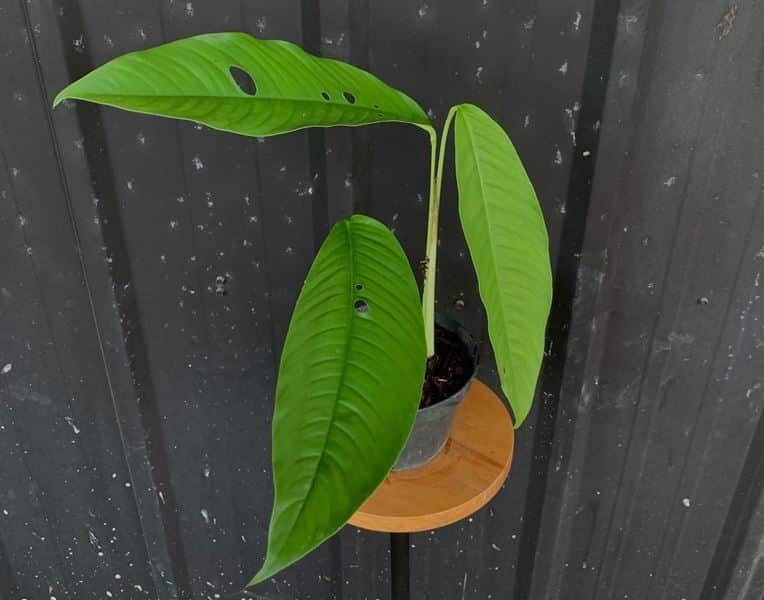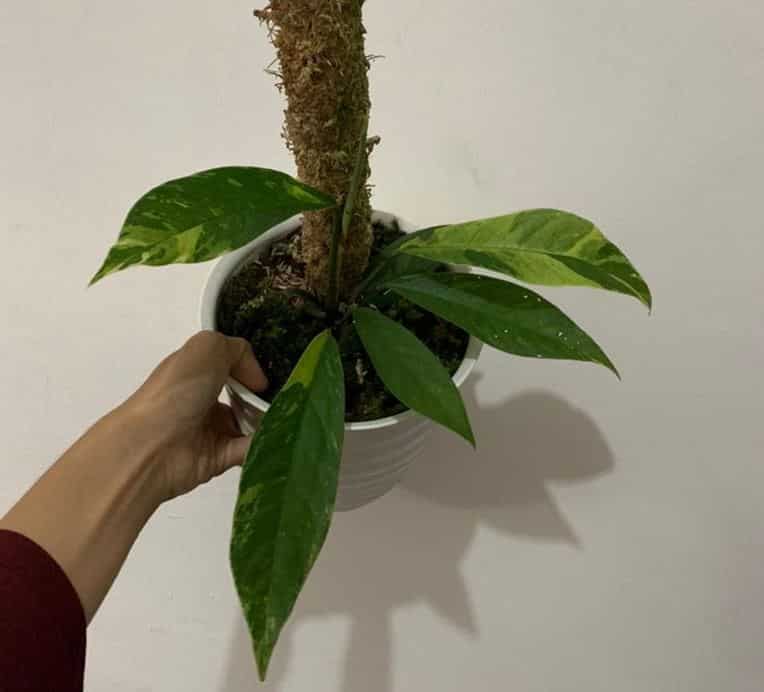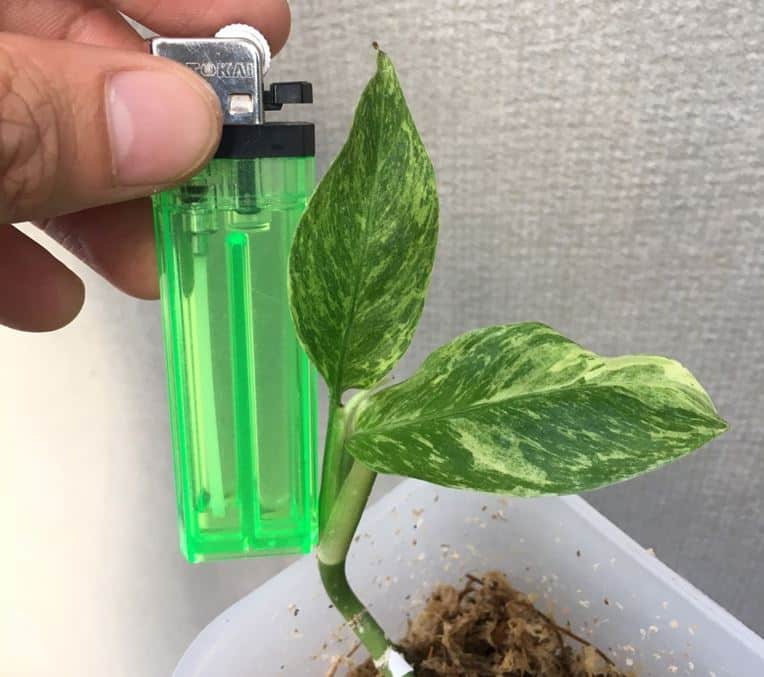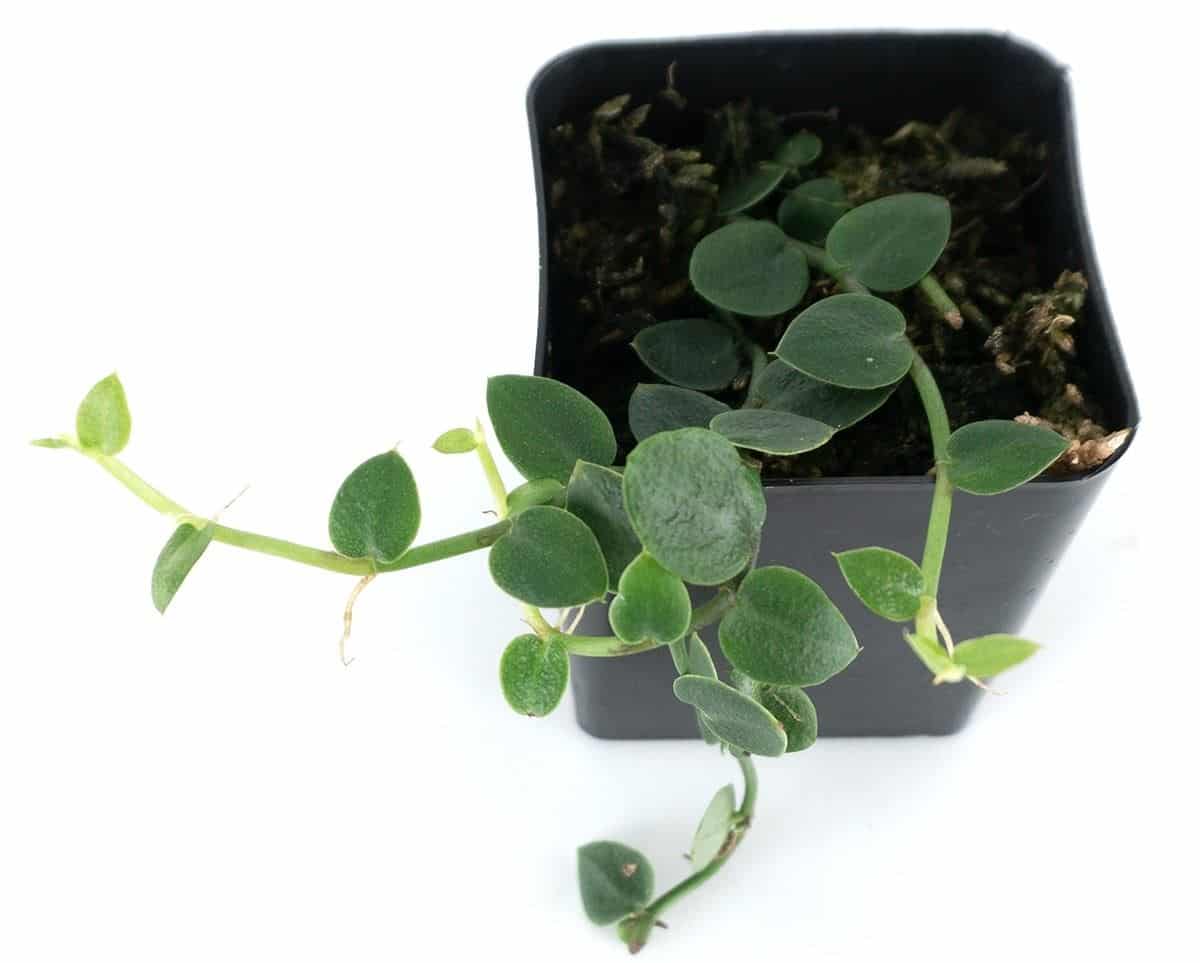Rhaphidophora foraminifera is a rare houseplant with elongated green leaves that dramatically gets larger and perforated when it matures. The oval to rhombic arranged near the midrib look amazing. Did you know you can go for variegated Rhaphidophora foraminifera, i.e., the mint and albo variegata too?
Discover more on R. foraminifera, including appearance (leaves, stems, and flowers), growing habits, and care (soil, watering, light, feeding, etc.). We will also look at turning yellow leaves, brown tips/edges, curling, drooping, etc.
Contents
- Overview
- Description and appearance
- 1. Growing habits
- 2. Growth rate and size
- 3. Rhaphidophora foraminifera leaves
- 4. Stems
- 5. Flowers and fruits
- Variegated Rhaphidophora foraminifera mint and albo variegata
- 1. Mint variegata
- 2. Albo variegata
- Rhaphidophora foraminifera care
- 1. USDA hardiness zone
- 2. Humidity
- 3. Temperature
- 4. Light needs
- 5. Best soil mix
- 6. Watering
- 7. Feeding
- 8. Pruning
- 9. Repotting
- 10. Staking
- Problems
- Where to find Rhaphidophora foraminifera on sale
- What is the Rhaphidophora foraminifera price?
Overview
- Scientific name: Rhaphidophora Foraminifera
- Synonyms: Epipremnum foraminiferum
- Tribe: Monstereae
- Family: Araceae (aroids or arum family)
- Native habitat: Malaya, Borneo and Sumatra.
- Toxicity: All plant parts are poisonous or toxic to humans, dogs, cats, and other pets. Why? Because they have sharp, needle-like calcium oxalates. Chewing it will cause severe oral burning, irritation, swelling, and redness. Furthermore, patients will drool, find it hard to swallow, lose appetite, and pets will mouth paw. So, ensure your pets or kids don’t reach this plant.
- Care level: Easy or low maintenance

Description and appearance
How does R. foraminifera grow, look like, or how can you identify it?

1. Growing habits
Rhaphidophora foraminifera is a moderate to large, robust, densely leafy liana native to Sumatera, Peninsular Malaysia, and Borneo. It occurs at altitudes of 164-3396 feet (50-1035 m) above sea level on shaded granite or limestone rocks, moist hill dipterocarp, or disturbed forests.
Younger leaves are entire but become perforated as it grows into adulthood.
2. Growth rate and size
R. foraminifera is a fast-growing liana that can grow up to 49 feet (15 m) long. But at home, it may not grow as long, with most hardly going beyond 8 feet unless grown outdoors.
3. Rhaphidophora foraminifera leaves
It has oval to oblong-lance-shaped or oblong-elliptic, slightly oblique green leaves with few to numerous round to rhombic perforation covering up to ¼ the width of either side of the leaf blade. But younger leaves are entire.
Their feel is membrane-like to slightly leathery, and they have hairs on the upper surface while still young that shade as they mature. Also, the veins are hairy on the lower surface, a distinguishing feature.
How about their petiole? R. foraminifera has long, 8.7-20.5 inches (22-52 cm), smooth grooved petioles except for the prominent upper geniculum that is pubescent. The lower geniculum isn’t noticeable, and the petiolar sheath that goes to the upper geniculum degrades, leaving behind a little netted weak fiber.
4. Stems
This aroid has smooth, mid-green stems with internodes 0.4-2.8 (1-7 cm) long and slightly oblique to straight leaf scars. The prophyll and cataphylls decompose to form black mucilage. This mucilage forms parchment-like remnants on growing leaves, petiole, and inflorescences.
Last but not least, these stems also have dense aerial roots, i.e., dense clasping growing from internodes and nodes and robust feeding roots. But they don’t have flagellate foraging stems.
5. Flowers and fruits
A single or two large cataphylls that quickly deliquesce to a black mucilage subtend the inflorescence and seldomly a leaf. When the mucilage dries, it may adhere to the growing spathe.
The spathe is canoe-shaped, dull pale to dark yellow, and persists until the stamens mature. Afterward, it falls leaves a large scar on the spadix base.
On the other hand, the spadix has dull, greenish-yellow small inflorescence flowers that turn to dark green in the fruiting stage before ripening and greenish-yellow when ripe.
Variegated Rhaphidophora foraminifera mint and albo variegata
Besides the usual green form, there is the variegated forms, i.e., the albo and mint variegata, see Etsy.com.
1. Mint variegata
Rhaphidophora foraminifera mint variegata is the predominantly available form. This adorable plant has green perforated leaves with vibrant light green marbling, blotches, and sectors
Would you like to buy it? Then you must be ready to spend a fortune. Its prices range from $300 to $1500 for a cutting to an established plant.

2. Albo variegata
Rhaphidophora foraminifera albo variegata is less common. It has green leaves with cream to white blotches, marbling, or sectors.

Unlike the mint variegata that is more common, only a few people have this albo variegata. How much does it cost? If you need one, be ready to pay $300 to $600.
Rhaphidophora foraminifera care
Rhaphidophora foraminifera care is similar to the more popular Rhaphidophora species like R. tetrasperma, decursiva, korthalsii, hayi, or cryptantha.
Here is how to care for your R. foraminifera:
1. USDA hardiness zone
USDA hardiness zone for R. foraminifera is 11 to 12, i.e., these plants are not frost-hardy. Also, they cannot stand freezing temperatures. Only people in these zones can grow them outdoors all year.
2. Humidity
As tropical plants, they prefer high humidity but don’t mind average household humidity. We recommend keeping humidity at 50% or more.
If your home has low humidity, increase it by misting your plant a few times a week, having a pebble tray, and moving plants to humid rooms like the bathroom or kitchen.
Also, you can put your plants together to create a micro-climate or buy a humidifier. Pure Enrichment® MistAire™ should work well for medium-sized rooms. It is quiet, affordable, and can run up to 25 hours.
3. Temperature
Their temperature range is 55 to 85 degrees Fahrenheit (12.8 to 29°C) but grows optimally at 70 to 80°F (21 to 27°C). Avoid sudden fluctuations, cold drafts, or heat stress.
Also, don’t put your plant near heat-emitting vents like a radiator, room heating systems, or near air conditioning vents.
If outdoors, move your plant into your house when temperatures reach 50°F (10°C) as they won’t be growing.
4. Light needs
R. foraminifera needs bright, indirect light for about 12 hours a day. Avoid direct sun as it will cause sunburn. So, place them at a distance from the window where direct sunlight doesn’t reach them, especially on the south or west-facing windows.
On the other hand, low light will slow growth, making your plant leggy with smaller leaves that may turn yellow. Variegated plants are susceptible since the variegated part don’t photosynthesize.
We recommend using 10,000 to 20,000 lux (1000 to 2000 footcandle) grow lights if your plant is in a poorly lit area. We have been using Relassy 15000Lux Sunlike Full Spectrum Grow Lamp for the past two years. So far, we can say it is effective.
To make sure your plant is getting enough light, why not buy a illuminance meter like Dr. meter LX1330B Digital Illuminance Light Meter.
5. Best soil mix
The best soil for Rhaphidophora foraminifera should be airy, well-drained, and high in organic matter. A slightly acidic potting mix of pH 6.1 to 6.5 is best, but one neutral (pH 6.5 to 7.3) will also work.
Buy an aroid mix from Etsy.com or make yours. A good blend should have perlite or pumice, coco coir/peat moss, bark chips/coco husks, and compost. You can also add charcoal and sphagnum moss.
6. Watering
They love moist soil. Soggy soil will cause root rot. So, we recommend watering Rhaphidophora foraminifera after the top 1-2 inches of the soil feels dry, i.e., up to the first knuckle of your finger.
It may be a few days to a week in the growing months and biweekly in non-growing. But since water needs vary with conditions and many other factors. So, first test the soil with your finger.
I prefer using my XLUX Soil Moisture Meter since its accurate and responds fast. You don't have touch the soil. If the reading is three or less, I know its time to water my plant.
Water your plant by slowly saturating the soil until excess water flows from drainage holes. After 15 minutes, discard any that collects in the cachepot or saucer.
7. Feeding
During the growing months, feed your plant once a month with an all-purpose, balanced, liquid houseplant fertilizer at half strength. Don’t feed in fall or winter.
I was initially using Bonide 10-10-10, which is perfect. I recently switched to Miracle-Gro Indoor Plant Food (Liquid), and I feed my plants after every two weeks. It is also good and feeds plants instantly.
If you prefer a slow-release formula, try Osmocote Smart-Release Plant Food Plus Outdoor & Indoor. Of course, it is not a balanced formula. However, it is good. Feed once every four months at a rate of 1 teaspoon per 64 square inches.
8. Pruning
Routinely cut dead, damaged, or diseased parts with sterilized gardening shears. To keep the shape, size, or growth you want, you can trim some branches during the growing season, especially early spring.
9. Repotting
Repot yearly during spring or early summer or if rootbound when actively growing. Once it’s the size you need, you can repot less frequently unless rootbound. When repotting, go for a pot 2-3 inches wider in diameter.
10. Staking
As a climbing liana, we strongly recommend that you provide and train your plant on a climbing trellis, totem, or moss pole.
Problems
As you grow Rhaphidophora foraminifera, you may encounter a few problems. Let us now look at some of these issues and possible causes.
| Issues | Comments |
| Pests | Uncommon indoors but may occur. Common pests are spider mites, thrips, scale insects, whiteflies, aphids, and mealybugs. Use insecticidal soaps, neem oil, or horticultural oil sprays to treat them. |
| Fungal and bacterial leaf spots and diseases | Not prevalent with proper sanitation. But fungal and leaf spots may occur. Signs include brown or black lesions on leaves and stems |
| Root rot | Overwatering is the leading cause. Signs include yellow leaves, wilting, mushy base, black or brown mushy roots, etc. If it hasn’t affected the whole plant, repot it, removing the decayed parts. Also, ensure you water your plants well, and your potting mix drains. |
| Leaves turning yellow | Most likely a sign of overwatering. But it may be due to too little light, too much light, cold drafts, nutritional deficiencies, etc. |
| Brown tips and edges | Brown tips and edges are a likely sign of leaf scorch due to underwatering, low humidity, too much light, or heat stress. Also, it may occur due to overfeeding, transplant shock, etc. |
| Leaves browning and brown spots | The most likely cause of brown spots are pests and disease but overwatering many cause brown splotches and cold draft overnight browning. |
| Leaves turning black or having black spots | Indicates pests or diseases and rarely frost damage or overwatering. |
| Leaves curling | It occurs to prevent moisture loss from leaves or prevent it from damage. Likely causes include underwatering, low humidity, too much light, heat stress, repotting stress, rootbound, etc. |
| Drooping | Plants droop when cells don’t have water to keep them rigid. The leading causes are a thirsty plant, low humidity, heat stress, and too much light. But root rot, overfeeding, and other things can be causes. |
Where to find Rhaphidophora foraminifera on sale
Rhaphidophora foraminifera is a rare aroid with only a few people selling it, especially in North America. You are unlikely to find it in big box stores or local nurseries, including those specializing in tropical plants.
The first place to consider is Etsy.com. It has the most expansive inventory with many vendors, including those in the US, Canada, Australia, and the UK, among other places. eBay is also good if you prefer a bidding kind of auction.
The other place to consider is Facebook and Instagram. These social media sites have many vendors. Select the one you can trust.
Last but not least, if you still haven’t gotten a vendor, use a search engine. Google “Rhaphidophora foraminifera for sale” and see the results you get.
What is the Rhaphidophora foraminifera price?
The standard Rhaphidophora foraminifera green form costs $30 to $100. But if you want the variegated form, you will pay more. Mint variegata goes for $300 to $1500 while albo sells at $300 to $600 and is rare.





Leave a Reply